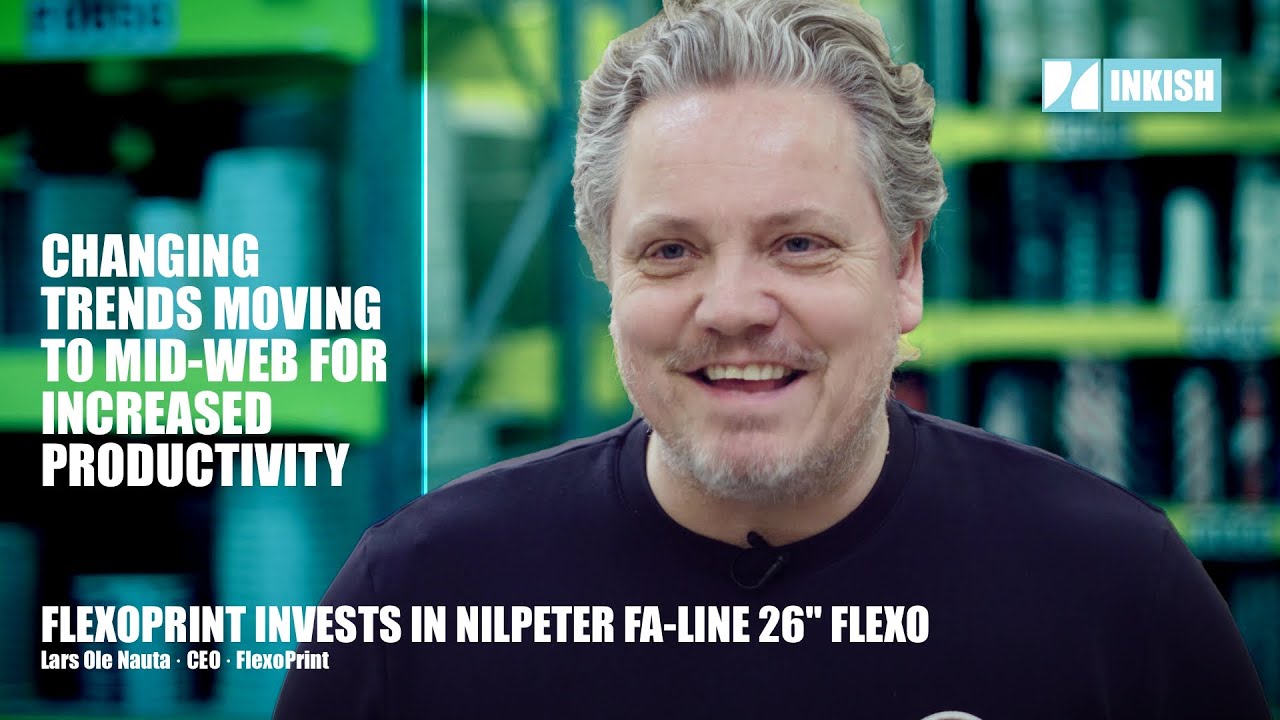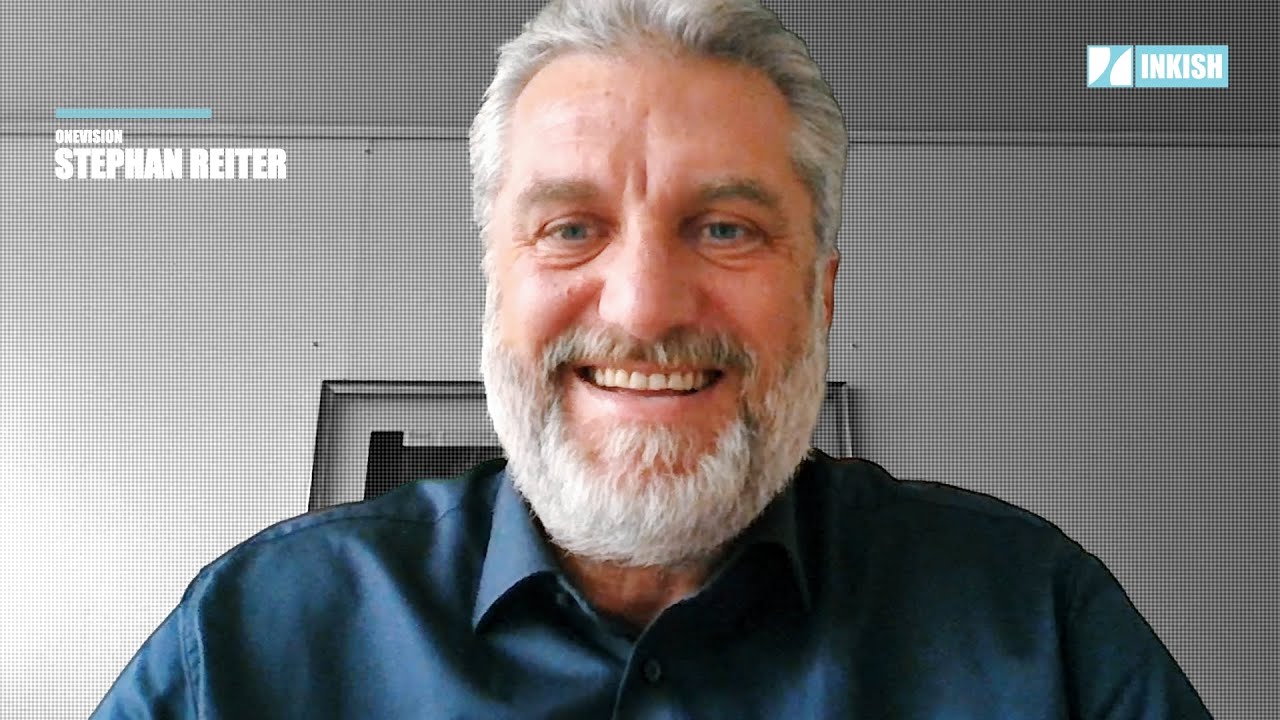The packaging market continues to surprise new innovative solutions, new capabilities, and a changing trend towards a wider format. FlexoPrint in Randers, Denmark, is one of Denmark’s leading flexo printing companies, serving customers in Scandinavia, Germany, and as CEO Lars Ole Nauta says, “Wherever there is an order, we try to get it.”
In this film, we get an insight into the recent investment of the Nilpeter FA 26″ machine, which, according to Nauta, serves a gap in the market. FlexoPrints flexibility to serve fast is a KPI that will help to fill the machine with more jobs.
Enjoy the film.
We are a manufacturer of self-adhesive labels. And we have been at this location since 2006. Yeah, that’s more or less who we are.
Just briefly, what kind of market is the self-adhesive label market?
Self-adhesive labels is still a valid and proper solution for our customers. It’s a good way of them branding their products. It’s easy and it’s cheap. Our share of the market is the labels that you see in the supermarket. Product labels, labels for decorative purposes. That is more or less who we are. So we do not make high-high-end labels. We make the day-to-day, normal label that everybody sees in the supermarket or somewhere else. Branding their products.
What markets do you serve?
In Denmark, we serve, we have the major brand on us, which we supply the labels for their products. Mostly fast-moving consumer goods products. We also supply labels in Denmark. We also have some exports to Sweden, to Germany and some other countries in Europe as well. So we wherever they order, we try to get.
When we walked through your company it seemed like a very lean operation…
Sometimes it is lean. It looks now lean because you are here today. But we try to…well I said in the introduction that we have very high wages in Denmark. We have the second highest wages for printers in Europe. Only Switzerland is higher. So we need to be effective. We need to be fast. We need to be smart. And to keep a good logistics angle is very essential for our business.
Do you also push certain products or services based on your technology and capabilities?
I don’t know any customers who would go to the technical side. Any customers who would like to have a label, we produce on a machine. Actually, it’s a question that we are beginning to ask our customers. Going five years back nobody wanted them to. They didn’t care. So today it’s an aspect. But for us, it’s still just on how to put color on a paper depends on the job, not on the machine and the technology. It seems like now that there are technology for digital, which is absolutely important and valid for short runs, of many sorts. And then you have still flexo which is also still relevant for in between. And our new LED machines that we got are for the very big orders and for more volume based orders.
What kind of demands do customers in label have today?
The way from idea to finished products in the supermarket is getting shorter and shorter. So we need to be outdoors. And we see a decline in quantity of orders. And we see more design changes. Of course in 2020 things were down a bit because we’re busy with other things. But there will definitely be the trend. Faster lead times, shorter service and so on. Then you could say: where does our LED machine fit in? Well that is because it’s for very large orders. Well, FlexoPrint is divided into all categories. So that’s where this new machine fulfills our needs.
What kind of challenges do you see from a producers perspective?
Just to give you an example. When we started in 2006, we were two printers more than we are today. And today we have tripled our turnover. So that is how the journey has been going. Going to the print side of it. The painting side, the slitting part is a different story. It seems like the need for efficiency or at least here flexo print for the printing efficiency we have dealt with. But on the other side, the customers still want their rolls to be packed in a certain box in a certain way. With a certain marking. So when another customer wants in a different way. So that is what will be our challenges in the future. That we need to see if we can standardize our slitting and painting departments a bit.
What kind of requirements do you have when you look into the new equipment?
The requirements that we want for our upcoming technologies is fast changeover times, lower waste and cost benefit, energy consumption. If you’re looking into a flexo machine, that’s what we need.
And based on that you decided to invest in a machine from Nilpeter?
We had a lot of customers where we are printing products that could be run better and more efficiency on the FA-26. And we also see a gap in between the big foreign printers and the narrow web business. And the narrow web business is getting wider and wider. When I started this business, it was two hundred millimeter machines. Then it was 250. And then there were 330 and then was 420 and 530. And now our machine is 660. So machines are getting wider and along with that they are getting wider we think there is a gap in the market for foil products in the mid-range area. And also on the commercial side there’s two different environments. The foil printers usually have very long lead times. Where we’re used to in the label business to have very, very short lead times. So we could combine our label world into the foil world. Perhaps there’s a market there. That was one of the reasons why we took this investment and this chance of investing in the Nilpeter 26 inches.
What is “the chance” from your perspective?
We don’t have orders for the entire turnover, that we need for the machine. We have some of it, of course. To make the ground breakage. But we need some more business. So actually, this is one of the first times we have taken a bit more chances than we are used to. But it is still a very solid calculation. But we need to get out there and market our new possibilities. Absolutely.
Could you describe what kind of machine it is?
The machine we chose here is the new FA line from Nilpeter, which we have followed over the last years. And we think all respect to Nilpeter. We think at the time now it’s freeness. It’s like we want it. It’s very lean. It’s very simple. And then we think that the LED colors we have been looking in for some years. And we think they are close to being on a standard in the world, colors are more aligned. The quality of the lamp is more aligned. It’s cheaper to change out a lamp if it goes fault. So we think that we are ready to go this way. And we did some thorough test runs on the FA-26. And we felt that it was right up our ally.
Did you need to adjust your finishing production workflow for the FA-26?
It’s very difficult with this new FA-26. If we wanted to produce labels to die cut in a 26 inch machines. It is simply too wide and too big. So you need to die cut it afterwards if you want to go into labels. Our main project here is not going to labels. But we have some very big orders. That it perhaps makes sense all the time to do it. We have just ordered a machine from REFIND where we are planning on die cutting our digital orders. And also take some of the things from our 26 inches just to play with it and see where we are. But we want to go further on labels with different lead and offline 26 inches die cut machine. But we are not there at the moment.
How much does a new machine play a role in being efficient in pricing and competitiveness?
It’s very important for FlexoPrint and also for the Optimum Group when we purchase machines. It’s not something we take lightly. Actually, I’ve always said buying hardware is one of the most difficult jobs as a CEO. Because where shoes you buy, it’s a major investment. It will follow you for many years. So we do a thourough investigation also with numbers to see on how many hours do we spend on certain machines. How many hours can be saved in the production? Meaning shorter lead times for other projects and putting into a machine. So that is months and months of calculating and thinking about which way to do. But at the end of the line, as every decision when you buy machinery. You always have to use this if you think for the last 20 percent. If you want to go that way. And we thought that it was the right choice for us.
Is it the first time you are working with Nilpeter?
Of course, I know Nilpeter is a Danish company. But I have to say that we have three MPS machines. And at that time we didn’t think that the FA was finished. So we thought the MPS EF 410 was more our alley. If we have seen the machine now,.. Looking back, we would definitely have chosen the Nilpeter. So we think the Nilpeter will be a part of us in the future. Also regarding normal flexo machines. Because we believe that the machines are where it is now and it’s good.
How has the collabroration been so far?
It has been a good cooperation. Has been very fast. Very on the money. Talking to people who can decide which is important for us. Open for ideas. And yes, it’s a great team. They know how to sell the machine. Know what we want. And of course, speaking in my native language, it’s always a bit easier. So that has been a very easy and good process, actually.
After only 2 weeks, is it too early to say anything about the productivity and ROI?
It is a bit early. But we can see on the speed it comes to what we have calculated with. We still have to work a bit out the changeover time. Because it takes too long to start a new machine. So everything is very interesting. When something happens, we need to make it a Monday to Friday machine. But if we get that right and we can put our old flexo spirit into our new machines, it will definitely be a good investment. And the quantity this machine can run without… We have other machines in 26 inches, in three shifts, is unbelievable. So yeah, we are ready.
You seem positive and I guess this is an important step for company growth right?
Well, I’m usually positive. It has been a hard year. But I try to be… Well you are in sales. Sales is all about selling positivity. That’s what it’s all about. So, yeah, we like to drive it. We would like to find our new product. We have our machinery. And then think: what kind of product can we put in? And it doesn’t matter what kind of product it is, in what business. As long as we can see a potential of a business idea and you can develop it. That’s the most important part for us.

























